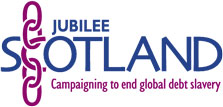
|
The story so far In the lead up to and during the Millennium Year, the Jubilee 2000 campaign forced the leaders of the richest states and the international financial institutions they dominate to take the issue of unpayable poor country debt seriously. Hundreds of thousands of campaigners worldwide took protest action, 24.1 million signed the petition for debt cancellation, and some of the most prominent people on the planet, from Bono to the Pope, gave their support to the campaign. Much was promised In the late 1990's the main creditors (the Group of 7 richest countries, the World Bank and International Monetary Fund) agreed various initiatives to alleviate the debt burden. Chief amongst these was the Heavily Indebted Poor Countries (HIPC) programme. This promised a "lasting exit from debt problems" for countries which met tough conditions set by the creditors. At the end of 2000 Britain also took unilateral action by undertaking not to collect further debt repayments from some of the poorest countries, and other members of the G8 (the elite club of the richest states) promised to follow this lead by varying degrees. Today a few countries are beginning to experience the benefits of debt relief. In Uganda, for example, the Government has put money released by debt relief into education with the result that the school enrolment rate has doubled. But not enough was delivered Gordon Brown's announcements on debt at the end of 2000, welcome though they were, were reported as if he had ended the debt crisis once and for all. In fact, the debts owed directly to Britain and other countries account for only part of the problem. Much of the debt is owed to the International Monetary Fund, the World Bank (which G8 countries including Britain ultimately control) and private banks. International initiatives on debt offer limited relief with harsh conditions attached for only some of the worst affected countries. Britain is still collecting debt payments from poor countries which are not included in the HIPC programme. The Jubilee 2000 campaign identified 52 poor countries urgently needing debt relief. Their collective foreign debts amounted to $372 billion in 1998, of which $300-$350 billion was unpayable (either literally or could be repaid only at an unacceptable human cost). The HIPC programme, as enhanced in 1999, promised $100 billion in debt cancellation. By May 2003 only $36.3 billion debt stock had actually been cut. The HIPC process is proving painfully slow and so far just eight of the 27 countries have reached 'Completion Point', the point at which there debts are cut to a level the creditors consider "sustainable". Creditors forced to acknowledge HIPC failure Reports published by the World Bank in Spring 2002 showed that, of the five countries which had completed the HIPC programme, two of them (Uganda and Bolivia) would still not be able to manage their debts. World Bank analysis is based on "projections" which debt campaigners question because 1) they assume much better performance by HIPC countries in the next decade than in the last and 2) that they discount the possibility of economic shocks, such as climatic disasters and currency devaluations, to which poor countries are vulnerable. Given a more realistic analysis the current state of HIPC is far worse. Creditors are now beginning to acknowledge that HIPC will not deliver debt "sustainability" as promised. Campaigners are now pushing to ensure that this realisation results not in tinkering with HIPC, which will simply postpone the crisis, but in a radical overhaul of the whole debt relief process and in a new, fairer relationship between rich creditors and poor country debtors. Where are we now? Debt update - some numbers to illustrate why the campaign must continue:
|
© 2006 Jubilee Scotland
Last modified 01-Mar-2006